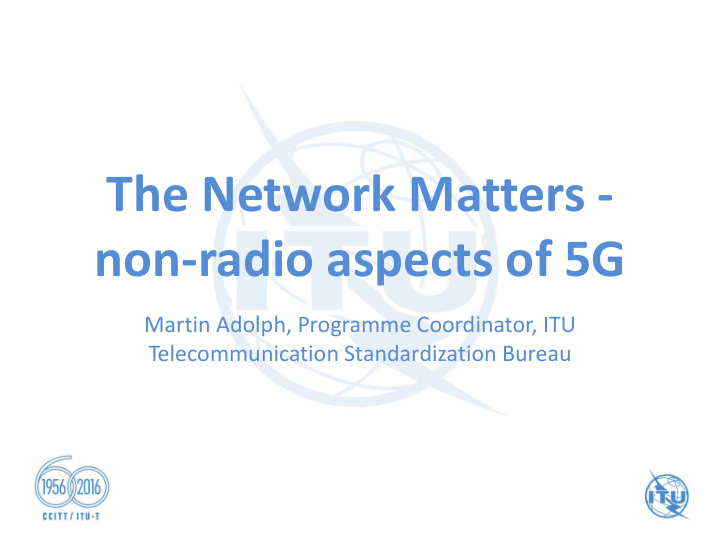



The Network Matters - non-radio aspects of 5G Martin Adolph, Programme Coordinator, ITU Telecommunication Standardization Bureau
Who we are?
What we do? Allocation of global radio spectrum and satellite orbits Bridging the digital divide ‘Committed to Connecting the Establishing international World’ standards
ITU 5G Vision (i) Enhanced mobile broadband Gigabytes in a second 3D video, UHD screens Work and play in the cloud Smart home/building Augmented reality Industry automation Mission critical application V oice Smart city Self driving car Future IMT Massive machine type Ultra-reliable and low latency communications communications M.2083-02 Source: Recommendation ITU-R M.2083, https://www.itu.int/rec/R-REC-M.2083-0-201509-I/en (09/2015)
ITU 5G Vision (ii) User experienced Peak data rate data rate (Gbit/s) (Mbit/s) Peak i m p or User experienced h t a g n i H c e Enhanced mobile data rate data rate 20 100 broadband IMT-2020 d i u M e m 10 1 Area traffic Spectrum Spectrum capacity Area traffic efficiency efficiency L o w 2 (Mbit/s/m ) capacity 10 3 ´ 1 ´ 1 0.1 1 ´ 350 10 ´ 400 100 ´ 500 IMT-advanced Network Mobility Mobility Network (km/h) energy efficiency energy efficiency Ultra-reliable 5 10 10 Massive machine and low latency type communications communications 6 10 1 Connection density Latency Connection density Latency 2 (ms) (devices/km ) M.2083-04 M.2083-03 “To achieve ultra-low latency, the data and control planes may both require significant enhancements and new technical solutions addressing both the radio interface and network architecture aspects .” Source: Recommendation ITU-R M.2083, https://www.itu.int/rec/R-REC-M.2083-0-201509-I/en (09/2015)
ITU-T Focus Group IMT-2020 • Studying the requirements and standardization needs of the wireline in support of 5G (explicitly non-radio/RF based) • Chair: Huawei; Vice-Chairs: CMCC (China), NTT (Japan), TI (Italy), ETRI (Korea) • Using ITU-R M.2083 and other 5G whitepapers as starting point, extrapolate what a 5G wireline network would look like • Led production of report with 85 identified gaps, http://itu.int/en/ITU-T/focusgroups/imt-2020
2015: Identifying the non-radio gaps Executive Summary + Gaps + Supplemental info Useful background • A.17 OAM protocols Priority: High • Description: OAM protocols are not standardized in some parts of IMT networks such as the front haul network. Standard OAM protocols should be studied for fault management and performance management between network equipment that may be commonly used across the IMT-2020 network. • Related work: • A.18 End-to-end network management in a multi-domain environment Priority: High Description: Multiple network management protocols in different network domains make it difficult to support unified network operations over multiple network domains. A unified end-to- end network management should be considered to ensure compatibility and flexibility for the operation and management of an IMT-2020 network. Related work: SG13 • A.19 Mobility management for distributed flat network Priority: High Description: As the IMT-2020 core network is envisioned to be a flat distributed network, which is composed of the multiple distributed gateways to cope with traffic explosion and latency requirements of applications, mobility management should be studied aligning with those architectural changes. Related work: 3GPP, SG13 Network Network Information centric Fronthaul/ E2E QoS Architecture Softwarization networking Backhaul
2016: Standards and PoCs • Tackling the gaps through: 1. Draft international standards: • Network softwarization, incl. slicing for front haul/back haul; • Information centric networking; • Network architecture refinement and fixed mobile convergence; • New traffic models and associated QoS and OAM aspects applicable to 5G architecture. 2. Demonstrations and prototyping: • Candidate: E2E network slicing
2016: Collaboration with Open Source initiatives Service Providers FG IMT-2020 Vendors 1 Proof-of-Concept • Containers – TransportSDN (Englewood) • 2 #1 Help consolidate POC • Docker • OpenDaylight ideas and work with Open 1 Kubernetes • • ONOS Source bodies. OPNFV • • Android 2 Co-ordinate POC tests/demos • Open-O Linux • Proof-of-Concept • O3 Project Fabric as a Service (FaaS) • #N • OpenStack • Open CCN OpenLTE • OpenAirInterface.org •
Moving forward • 8-11 March 2016, Seoul, Korea (hosted by KT): Initiated work on draft standards, saw demos and discussion of PoCs. • 17-20 May 2016, Beijing, China (hosted by China Mobile, Datang): Progress reports/draft standards; narrow down, agree on scope of PoCs and demos. • TBC: 6-9 September 2016, Palo Alto, United States (hosted by PARC): Progress reports/draft standards; progress the development of PoCs and demos. • TBC: 8-11 November 2016, Geneva, Switzerland (ITU HQ): Finalize and adopt reports/draft standards; presentation of PoCs and demos. • 25 May 2016, San Diego, United States : ITU/NGMN Workshop on Open Source and Standards in 5G.
Recommend
More recommend